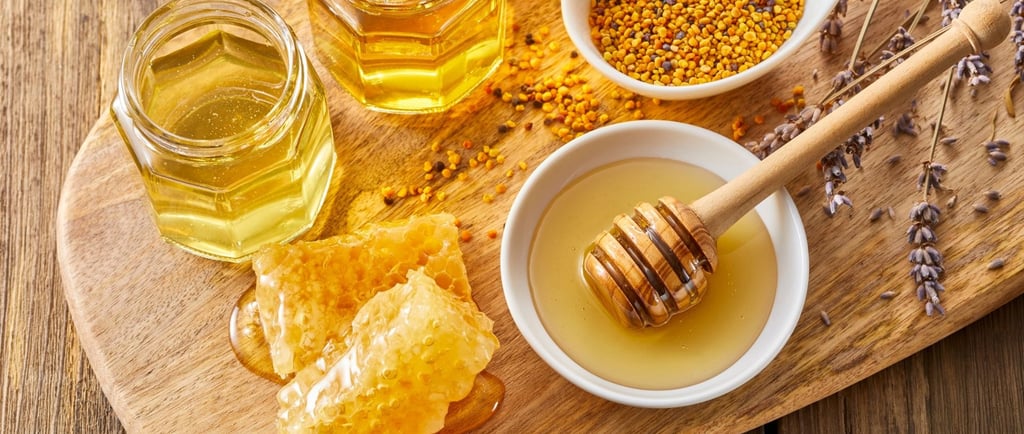Maya Honey: The Liquid Gold of the Mayab
Since ancient times, honey has been regarded as a sacred gift of nature. For the Maya people, this sweet nectar was more than just food—
INGREDIENTES DE LA REGIONCOCINA LOCAL Y ANCESTRAL
Ro Madrid
6/25/20253 min read


Maya Honey: The Liquid Gold of the Mayab
Since ancient times, honey has been considered a sacred gift from nature. For the Maya people, this sweet nectar was not just food: it was medicine, offerings, and a symbol of balance between humanity and the universe. Today, in the jungles of southeastern Mexico, melipona honey, produced by a native stingless bee, continues to be one of the most valuable ingredients of the living Maya culture.
Welcome to the fascinating world of Maya honey, an ancestral product that is now regaining strength thanks to guardian communities of tradition and chefs who proudly incorporate it into their dishes.
Melipona: The soul of sacred honey
Traditional Maya honey comes from the bee melipona beecheii, an endemic species of Mesoamerica that has no sting and produces honey with a complex flavor, slightly sour and less viscous than common honey.
These bees were considered sacred by the Maya, who cared for them in hollow trunks called jobones. Their honey was not collected industrially, but as part of a spiritual and medicinal ritual. There is even a protective deity: Ah Mucen Kab, the Maya god of bees.
Ancestral uses of Maya honey
For the Maya, honey was not just a sweetener, but a vital element for physical and spiritual balance. Some of its traditional uses include:
Natural medicine: to treat infections, wounds, respiratory diseases, and digestive issues.
Rituals and offerings: as a symbol of fertility, abundance, and connection with the gods.
Ceremonial food: mixed with cocoa, corn, or fruits on important dates.
Natural cosmetics: applied to the skin as a regenerator and antiseptic.
Melipona honey is antibacterial, antioxidant, antifungal, and probiotic. It is, literally, a liquid gold full of life.
Maya honey producers in the region
Throughout the Riviera Maya, and especially around Tulum, Maya communities have preserved the tradition of meliponiculture, passed down from generation to generation.
Among the notable communities and cooperatives are:
Cobá and Punta Laguna: where you can visit traditional apiaries and learn about jobones.
San Juan de Dios and Sacalaca (Felipe Carrillo Puerto): producers who sell pure honey and derivatives at local fairs and markets.
Community meliponaries in Muyil and Chemuyil: initiatives that combine ecotourism, environmental education, and sustainable production.
Many of these projects not only generate income but also conserve the jungle and promote Maya cultural identity.
The honey in Maya gastronomy
Honey has historically been an important ingredient in Yucatecan cuisine, both in everyday and ceremonial dishes. Its delicate and floral flavor is used for:
Traditional dishes:
Papaya sweet with honey and cheese
Xpelón tamales with honey
Pibinal: corn cooked with honey, traditional in offerings.
Chicken with white recado and honey
Tzic with honey and bitter orange dressing
Drinks:
Balché: ceremonial drink made with honey, fermented bark, and water.
Fresh waters with melipona honey, instead of sugar.
Contemporary cocktails with jungle honey and local spirits
Contemporary cuisine: from the ritual to the gourmet
Today, Maya honey is being revalued by chefs in Tulum and across the Riviera Maya. Some use it to glaze fish, flavor sauces, or enhance signature desserts. It is also integrated into chaya and honey vinaigrettes, reductions for wood-cooked meats, and herbal infusions.
This gastronomic approach not only honors the past but also projects the product towards a future full of flavor, health, and sustainability.
A jewel to preserve
Maya honey is not an industrial product. Its production depends on the ecological balance of the jungle, artisanal care, and indigenous knowledge. Promoting its conscious consumption means:
Supporting Maya communities
Conserving native species like melipona
Strengthening food sovereignty
Enriching the gastronomic offer of Tulum with identity
"Honey not only sweetens... it also connects: with the land, with history, and with the soul of the Mayab."
Where to taste and buy Maya honey in Tulum
Tianguis and artisanal markets in downtown Tulum
Ecotourism projects in Cobá, Muyil, and Maya communities
Restaurants like Cetli, Arca, or NÜ, where they incorporate it into traditional or contemporary recipes
Community meliponaries with direct sales of pure honey






